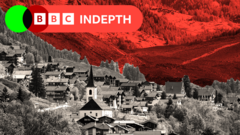In Switzerland's Loetschental valley, the quaint village of Blatten has vanished under debris after a catastrophic landslide triggered by a glacier collapse. Mayor Matthias Bellwald's own home lies just 3 miles away from the site of destruction. This tragic event followed a precautionary evacuation of Blatten's 300 residents, who lost not only their homes but also their church, hotels, and family farms.
Local sentiments echo with grief, as hotel owner Lukas Kalbermatten reflects on the memories tied to the charming alleys and structures now buried under rock and mud. With rebuilding efforts projected to be complete by 2029, the hefty costs raise an urgent question: Is investing hundreds of millions of dollars to restore Blatten worth it?
As researchers highlight the perils of global warming, it becomes evident that the melting glaciers and unstable mountain structures could threaten more villages across Switzerland. Historical data suggests that the spending on protection against natural hazards may need to increase exponentially to ensure safety in these mountainous regions, provoking a nationwide discussion about the sustainability of preserving all alpine inhabitants.
The implications of climate change extend beyond mere economics; cultural heritage is at stake too. As populations in the Alps wonder about the fate of their traditions, the word "heimat" surfaces as a poignant reminder of their ties to these landscapes, rich in history and identity.
Recent studies report that warmer temperatures are increasingly causing devastating geological events in the Alps, leading climate scientists to argue that the complexity of these disasters is growing. While residents of Blatten aim to return to what was once debated as a once-in-a-millennium incident, the reality is that these landslides are now more frequent and unpredictable.
Communities are wrestling with the potential of entire areas being abandoned as public sentiment shifts towards protecting life and preserving stability. Other villages, like Brienz, are already grappling with the aftermath of evacuations as threats loom ever closer. Heavy rainfall has prompted new warning signs in various parts of Switzerland, leading residents to urgency and fear.
As the country evaluates how to move forward in preserving its alpine villages, a balance must emerge between the emotional attachment to these landscapes and the harsh realities posed by climate change. With community recovery efforts underway, every citizen's experience reminds us of the fragile nature of life in concert with the enduring, yet perilous mountains.
The echoes of Swiss heritage hang in the balance as the nation decides how to confront these climatic challenges, with a determination that their beloved landscapes and cultures forged through generations must not be allowed to fade away.



















